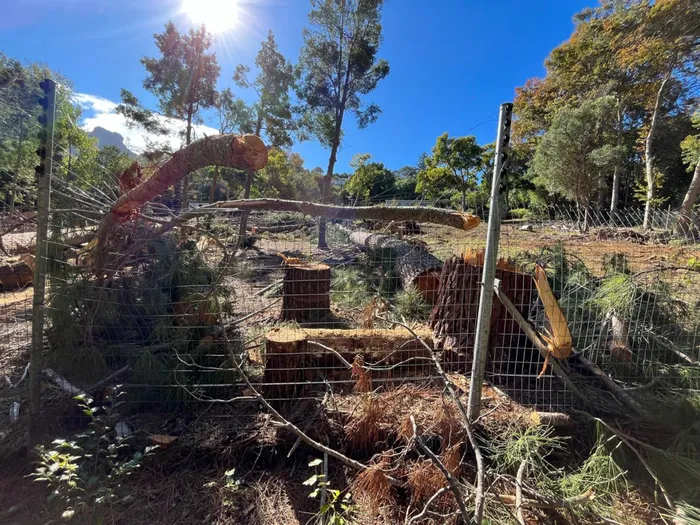Greenbelt tree felling draws outrage

The felling and clearing of trees at a Constantia home and on nearby public greenbelt land has residents and environmental groups seeing red. Picture: Janice Matthews
The trimming and felling of trees on a Spilhaus Avenue property and an adjoining strip of the Klaasenbosch Greenbelt to “improve the view” has left Constantia residents and environmental groups fuming.
However, the landowner, Jerome Cedras, says the clearing on his property was lawful, and he asks that no “hasty or mischievous” conclusions be drawn about the “very unfortunate incident” on the public greenbelt while the City’s recreation and parks department investigates.
Mr Cedras said his property had been overgrown, creating home-invasion, squatting and fire risks for neighbouring properties.
A contractor was to blame for the felling and pruning of pine trees on municipal greenbelt land next to his property, and he would give his full cooperation to the authorities investigating it, he said.
Mayoral committee member for community services and health Patricia van der Ross said the City had met with Mr Cedras on Tuesday April 16 to discuss reckless tree felling on his property that had damaged his own Outeniqua yellowwoods.
“Mr Cedras requested to remove the large pine trees on City land to improve his view. After an assessment, the request was declined as the trees were deemed healthy and posed no risk to the property. The City’s recreation and parks department confirms that no authorisation was given to cut down the mature pine trees on council land. Prior approval must be obtained from the department for all tree trimming, tree removal and tree root pruning requests.”
Ms Van der Ross declined to comment further until the department had finished its investigation.
The Friends of Constantia Valley Greenbelt said not only had 95% of trees been felled at a previously canopied site, but clearing and pruning trees on public land without a permit was a flagrant breach of City by-laws and heritage laws.
“The trees felled in the greenbelt fall into a Grade 3A heritage site of significant cultural landscape heritage to the City of Cape Town,” said the group’s chairman, Colin Walker.
More than 80% of the trees on the lower end of Mr Cedras’s property had been indigenous, some more than 50 years old and six metres tall, and the property owner had not had a permit from the Department of Forestry Fisheries and the Environment to remove the trees, said Mr Walker.
Trees felled and topped on the greenbelt had been within 30 metres of Mr Cedras’s boundary fence, said Mr Walker.
“Huge pines were felled with a single cut midway up the trunk. As a result the whole crown of the tree with full weight and span of at least 15 metres crashed onto the trees below. This caused appalling damage to at least 1000m² of prime indigenous woodland.”
It was a “textbook example” of what happened when “unscrupulous developers” pushed the boundaries of the City’s densification policy in City-recognised non-growth areas, he said.
Public greenbelts were meant to protect the tree canopy and nature, he said. “In this case, it appears to have been destroyed by the landowner with impunity.”
Parkscape founder Nicky Schmidt warned that urban forests were being lost at an “alarming rate” to development, the tree-killing polyphagous shot hole borer beetle and “purist conservation endeavours”.
Global urban forest averages were nearing a minimum of 30%, but the City’s was “woefully backward” at 6%, and the polyphagous shot hole borer beetle was expected to destroy 40% of that, she said.
“We have to, as a matter of urgency, ensure two things: prevent further loss and destruction of the urban forest and plant a lot more trees.”
The City has cautioned the public against the removal of trees and to immediately report all tree incidents on City land to the City’s public emergency communication centre at 021 480 7700 from a cellphone or 107 from a landline.

Related Topics: